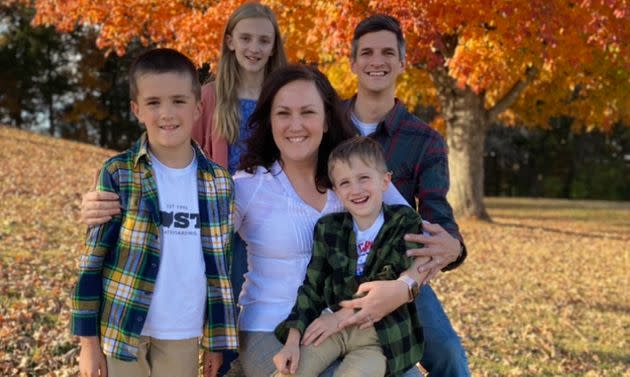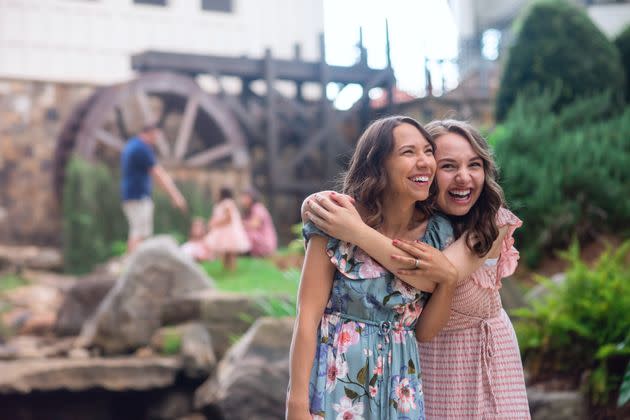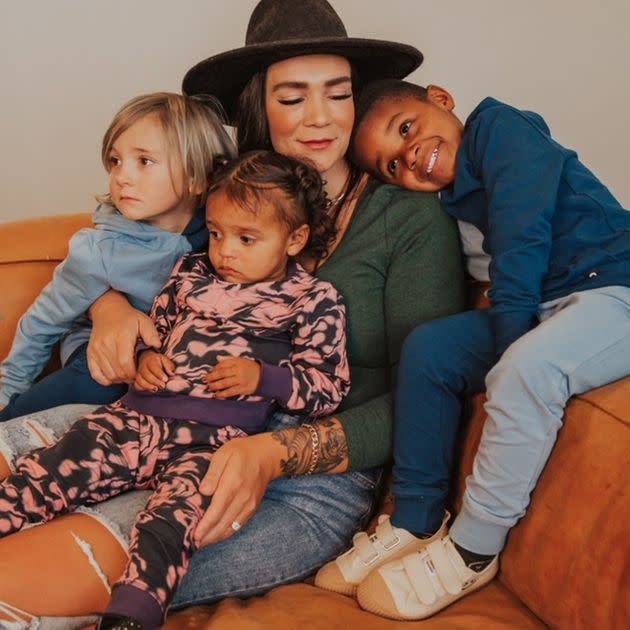An Open Adoption Means 'Extra Love And Family' — If All Goes Well
Jennifer Mae is a 36-year-old who parents three kids in northwest Ohio. But they aren’t her only children.
When Mae was 17, she gave birth to a baby girl whom she placed for adoption “to protect my child from a biological father that could not, would not show up for her the way she deserved,” Mae said.
“I couldn’t provide her with the finances, time and attention I believed she deserved from her mom,” she continued. “I chose parents who could provide all that and more for her.”
The adoption was characterized as “semi-open,” which in this case meant that the adoptive family agreed to send Mae updates and pictures.
“They kept their word,” she said, and “even sent full scrapbooked pages for me to add into a scrapbook binder they gave me.”

Jennifer Mae, her husband and their three children mark her daughter's birthday each year.
But the open part of the adoption was time-limited. After two years, as planned, the updates stopped, closing communication between Mae and the adoptive family.
“I did not know then what I know now ― open is best practice,” Mae said. “I do not regret placing my child ... but I do regret having a closed adoption. My daughter doesn’t know that I love her nor that I placed her to protect her, and I don’t know if she is safe, loved or well.”
Every year on her daughter’s birthday, Mae, her husband and their children mark the occasion with a cake.
“We sing ‘Happy Birthday’ and talk about what we think my placed daughter is doing,” wondering whether she got her driver’s license when she turned 16, for example, she said.
Sometimes, she has to excuse herself to go to another room and cry.
While adoptions have become more open since the time Mae placed her daughter, she hopes that we “can shift the adoption culture ... so no more women and families have to experience the monumental loss of their child through closedadoption.”
What does it mean for an adoption to be ‘open?’
The idea that birth (or “first”) families could remain in contact with adoptive families represents a dramatic shift from how adoptions were approached decades ago. Back then, records were sealed and children were given no information about their birth parents, much less an opportunity to make contact with them.
That was “fully closed adoption ― the adoption of a generation ago,” said Nicole Witt, executive director of the Adoption Consultancy.
Children and birth families suffered under this traditional, secretive arrangement. As more research explored the experiences of adoptees, adoption professionals reached the consensus that it is better for adopted children to learn about and be able to make contact with their birth families.
“Every once in a while you still get a case where the birth mom wants closed,” said Witt, but open adoptions are now the norm in the United States. A 2012 report from the Evan B. Donaldson Adoption Institute estimated that only 5% of domestic adoptions are closed ones.
What “open” means, however, varies significantly from state to state — each has its own adoption laws — as well as from family to family, and even within the same family over time.
In what Witt calls a “totally open adoption,” there is “an exchange of identifying information, and/or the communication is directly between the adoptive parents and the birth parents, without a middleman.”
“Semi-open” involves some interaction during the process but not an exchange of identifying information, Witt said. For example, the birth mother and adoptive family might meet in the offices of an agency or lawyer, but they would not learn each other’s names or addresses. Once the baby is born, communication occurs via a third party, such as the adoption agency if one is involved.
Unlike Mae’s experience in 2004, Witt said that these days, “semi-open” relationships often evolve to become more open as time goes on. Parents might move to communicate directly with birth parents rather than via a third party, for example.
“Once people realize that everybody’s respecting the boundaries, then it just kind of happens,” said Witt, who noted that while many adoptive parents are hesitant at first about the openness of the adoption, they often end up being the ones asking for more contact with the birth mother.
Leah Outten of Charlotte, North Carolina, planned to parent her child when she became pregnant at 16.
“But as the months ticked by, I did not feel peace with parenting,” Outten said. “I realized that I was setting her up for a life very similar to the one I grew up in if I parented her, and I desperately wanted to give her a different life. A more stable life.”
But adoption as she knew it — closed adoption — also didn’t feel right.

Leah Outten has maintained a relationship with her daughter, who is now 18 years old.
When Outten found birth moms online telling their stories of open adoption, “it opened my eyes to what was possible, and that helped me make a more informed decision,” she said.
Outten and the couple who adopted her child agreed to stay in touch, communicate regularly and visit one another twice per year. They wrote up a formal agreement and had it notarized.
Outten visited with her daughter on a monthly basis when she was little, actively participating in her care. Of her relationship with her daughter’s adoptive parents, “It was extra love and family for me,” Outten said.
As she got older, Outten’s daughter came to visit her during the summer.
“Through the years our number of visits and contact has ebbed and flowed, but we never have lost contact and maintain our relationship with intention,” Outten said.
Meg St-Esprit, a Pennsylvania mom to four kids via adoption, has written about the experience of building a family this way, noting the short history of open adoption.
“We are part of a fairly new crop of mothers navigating open adoption and figuring it out as we go,” she wrote, describing the unique bond she shares with her children’s birth mothers.
“Our kids deserve to know their whole story and be connected to all of their important people. It’s our job as the adults to cultivate that,” she wrote.
In some cases, birth and adoptive parents become family to each other.
Some families begin their relationships with a high degree of openness.
Heather Crockett Oram is a Utah mother of five. She has two stepsons and three adopted children. She and her husband initially advertised their intention to adopt on social media with the goal of securing a private adoption and avoiding what they saw as steep fees charged by agencies.
The cost of an adoption via a private agency is typically $30,000 to $60,000, according to the Child Welfare Information Gateway, part of the Department of Health and Human Services. Parents who find the birth mother themselves and then secure their own lawyers tend to pay $25,000 to $45,000.
Crockett Oram’s first connections in the process were with the birth mothers themselves, and they took place over text messages and social media. In the years following, Crockett Oram and her husband have nurtured close ties with their children’s birth mothers.

Heather Crockett Oram, who goes by @heathercrock on Instagram, with her three youngest children.
During a time when one child’s birth mother was struggling, she asked Crockett Oram to take in another, older, son. The boy lived with them for seven months, as did a little sister the following year. She stayed for five months, returning to her mother when the pandemic hit.
In 2020, when the family adopted a little girl, they also housed the birth mom for the last month of her pregnancy. The family has even taken a trip to Disneyland with one of the birth mothers and her other children.
“We wanted open adoption with all of our families,” said Crockett Oram. “It’s better for the child — if it’s healthy.”
She said she wants her kids to know that they were placed for adoption out of love during difficult circumstances, and the open adoption enables her kids to have other questions answered as they arise.
Families need to agree on exactly what communication will look like.
Some adoptive families communicate regularly with birth mothers via text messages or social media, while others only talk a couple of times a year over email. The spectrum of openness within open adoptions is wide.
Of course, everyone comes to the table with different expectations, and needs shift over time. Oram Crockett has had to limit communication with one birth mom due to conflict.
Celeste Liversidge, an adoption attorney who founded the organization AdoptMatch to help birth mothers connect with ethical adoption professionals, said that it is essential for families to design a post-adoption contact agreement, or PACA, before the adoption is finalized.
The PACA “is a written agreement that includes the terms and parameters outlining how birth parents and adoptive parents will communicate after the adoption,” said Liversidge.
“These agreements are only enforceable by a court in some states; however, even where they are unenforceable, PACAs can be a valuable tool to create a baseline for communication and set expectations for the future,” she added.
According to AdoptMatch, 25 states plus the District of Columbia have laws that make PACAs enforceable. Seven states have laws making them enforceable only under certain circumstances. Six states have laws that make PACAs unenforceable, and 20 states don’t have laws about open adoption agreements at all.
Kayce Kean, who shares on TikTok about placing a baby for adoption, lives in Indiana, one of the states where PACAs are only enforceable under certain circumstances.
“I was a 17-year-old ward of the state, living in a group home, and they didn’t give me abortion access,” said Kean, who uses they/them pronouns.
Parenting their child wasn’t a viable option for Kean, either.

Kayce Kean at the time of their pregnancy.
“My case manager told me that they were going to place my child in a temporary foster home until they approved my release from the group home, which could have been as late as 21,” the now 25-year-old said.
In addition, Kean believed that they weren’t in a place to be “a fit parent.”
“I grew up poor with addict parents, and I didn’t have the emotional intelligence or the financial resources to break the cycles of generational trauma, and I knew in my heart it wasn’t right to bring a child into our chaos,” Kean said.
Going into the open adoption, Kean understood that the adoptive parents would communicate with them.
“I was expecting to be able to stay in some form of direct contact with the adoptive parents and would be able to play a more active role in [my daughter’s] life,” they said.
But the adoption, while technically still semi-open, hasn’t turned out as they hoped.
The family emailed with Kean a few times before the birth and for the week following their daughter’s arrival.
“Then I never directly spoke to them again,” said Kean. “It feels like they just took my baby and forgot I existed.”
“I get a yearly update from the adoption agency, but I can’t interact at all, it’s all done through a third-party site,” they said. “It’s very formal and not at all what I had in mind when they said I’d be getting ‘updates.’”
Liversidge founded AdoptMatch to prevent this type of situation. She believes that families — birth and adoptive — can avoid some problems by talking through the following issues before making the match, whether through an agency or a private attorney.
Expectations for communication and contact, including how any disputes will be resolved. These same issues should be discussed again after the match is made and the families are working on the PACA.
Expectations of financial support for the expectant parent. Laws vary from state to state, so families will need the guidance of an adoption professional here. Liversidge emphasized that birth parents should know they are entitled to counseling both before and after the birth.
Access to adoptive parents’ home study, of which expectant parents should be able to receive a redacted copy.
Role of the birth father.
Other topics such as the name that will appear on the child’s original birth certificate, educational plans for the child, and the role of religion in the child’s life.
Any other issues that are important to the expectant or adoptive families.
Both expectant and adoptive parents should feel comfortable asking questions of lawyers or other professionals involved.
“Amounts and descriptions of fees being charged should be disclosed to both parties” by the attorneys involved, Liversidge said.
Both Kean and Crockett Oram expressed doubts about some adoption professionals, particularly given the large sums of money that the process involves.
“Agencies will say anything they can to make money ― it’s an inherently exploitative practice,” said Kean.
To make sure that the adoption professional they are working with practice ethically, Liversidge advises that adoptive parents ask whether the expectant parents will be provided with separate legal representation as well as post-placement counseling from a licensed, adoption-competent professional — both at no cost to them.
It’s also important to confirm that a PACA will be used, even if it will not be enforceable in the state where the adoption is finalized.
Outten explained that even with a PACA, and particularly in some states, “open adoption isn’t always a guarantee because families can easily make promises and not follow through.” For this reason, she advises birth moms, “trust your instincts on the family you choose. If you feel or see any red flags, you can always find another family who will love you like family.”
There is no way to predict every challenge that might arise, but families should clearly understand what the expectations are before the adoption takes place.
“The relationships created in an adoption are lifelong. There will be highs and lows just as in any other relationships,” said Liversidge.
Despite their negative experience, Kean acknowledged that “open adoption can be a very beautiful thing.” But such an outcome requires comprehensive planning and communication.
“This isn’t a fairytale,” said Kean. “It’s a real human being with an entire life ahead of them.”

